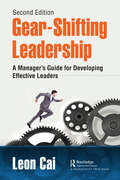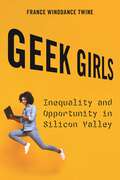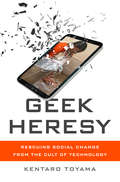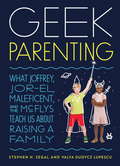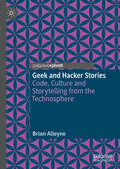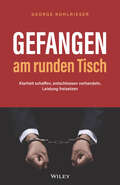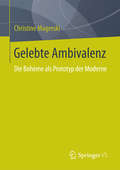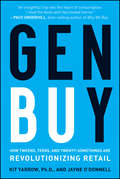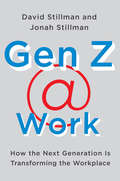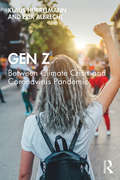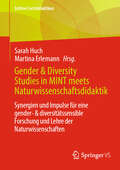- Table View
- List View
Gear-Shifting Leadership: A Manager’s Guide for Developing Effective Leaders, Second Edition
by Leon CaiDrawn from his experience as the executive dean of Wilner Sales and Leadership Institute, Leon Cai shares his proven philosophy and methods for improving leadership skills among middle and high-level managers. Leon is one the top ten most influential trainers in China winning “Honor China Award” and is a leading figure in China’s training and consulting industry. Gear-Shifting Leadership, now in its Second Edition, is a book designed to improve leadership ability of practicing managers and addresses the full spectrum or panorama of what is expected from successful leaders. Managers need to grasp more than just one or two aspects of leadership, but the whole content and complete framework of it. Gear-Shifting Leadership, Second Edition provides the concepts, tools, and examples needed for managers to become effective leaders. Updated with new examples and tools, Gear-Shifting Leadership, Second Edition synthesizes dozens of leadership models, and fully displays "the panorama of leadership." The author demonstrates the panorama by showing the links and connections between different parts of leadership. The book displays the four gears and nineteen components of leadership managers need to develop. The four gears are: Followership, Face-to-face Leadership, In-Direct Leadership, and Organizational Executive Leadership. • Followership refers to the ability of leaders to win the trust from subordinates, superiors, and counterparts through demonstrative self-management. • Face-to-face Leadership demonstrates the leaders’ ability to drive, encourage, instruct, manage, control, and develop direct subordinates and core teams. It exhibits leaders’ one-on-one leadership abilities targeted at their direct subordinates. • Indirect Leadership shows the leaders’ influence and driving power towards indirect subordinates and the whole team, and it can be defined as the leaders’ role in managing the team as a whole. • Organizational Executive Leadership shows leaders’ acute insight of the dynamic changes in their organizations, and the leaders’ ability to optimize their own approach to managing the team and in so doing, adapt to changes in both the internal and external environment of organizations. The book walks readers through each gear as well as the several components it comprises. Many leadership books have excellent concepts and ways of thinking, but lack practical sheets, models and tools, so that books of this type can only improve leaders themselves and can’t be widely used in their organizations. Gear-Shifting Leadership illustrates the model, tables, evaluation questionnaires, and simplified tools that will make the material in this book practical and applicable.
Geek Girls: Inequality and Opportunity in Silicon Valley
by France Winddance TwineChoice Outstanding Academic Title for 2023An inside account of gender and racial discrimination in the high-tech industryWhy is being a computer “geek” still perceived to be a masculine occupation? Why do men continue to greatly outnumber women in the high-technology industry? Since 2014, a growing number of employment discrimination lawsuits has called attention to a persistent pattern of gender discrimination in the tech world. Much has been written about the industry’s failure to adequately address gender and racial inequalities, yet rarely have we gotten an intimate look inside these companies. In Geek Girls, France Winddance Twine provides the first book by a sociologist that “lifts the Silicon veil” to provide firsthand accounts of inequality and opportunity in the tech ecosystem. This work draws on close to a hundred interviews with male and female technology workers of diverse racial, ethnic, and educational backgrounds who are currently employed at tech firms such as Apple, Facebook, Google, and Twitter, and at various start-ups in the San Francisco Bay area. Geek Girls captures what it is like to work as a technically skilled woman in Silicon Valley. With a sharp eye for detail and compelling testimonials from industry insiders, Twine shows how the technology industry remains rigged against women, and especially Black, Latinx, and Native American women from working class backgrounds. From recruitment and hiring practices that give priority to those with family, friends, and classmates employed in the industry, to social and educational segregation, to academic prestige hierarchies, Twine reveals how women are blocked from entering this industry. Women who do not belong to the dominant ethnic groups in the industry are denied employment opportunities, and even actively pushed out, despite their technical skills and qualifications. While the technology firms strongly embrace the rhetoric of diversity and oppose discrimination in the workplace, Twine argues that closed social networks and routine hiring practices described by employees reinforce the status quo and reproduce inequality. The myth of meritocracy and gender stereotypes operate in tandem to produce a culture where the use of race-, color-, and power-evasive language makes it difficult for individuals to name the micro-aggressions and forms of discrimination that they experience. Twine offers concrete insights into how the technology industry can address ongoing racial and gender disparities, create more transparency and empower women from underrepresented groups, who continued to be denied opportunities.
Geek Heresy: Rescuing Social Change from the Cult of Technology
by Kentaro ToyamaIn 2004, Kentaro Toyama, an award-winning computer scientist, moved to India to start a new research group for Microsoft. Its mission: to explore novel technological solutions to the world’s persistent social problems. Together with his team, he invented electronic devices for under-resourced urban schools and developed digital platforms for remote agrarian communities. But after a decade of designing technologies for humanitarian causes, Toyama concluded that no technology, however dazzling, could cause social change on its own. Technologists and policy-makers love to boast about modern innovation, and in their excitement, they exuberantly tout technology’s boon to society. But what have our gadgets actually accomplished? Over the last four decades, America saw an explosion of new technologies - from the Internet to the iPhone, from Google to Facebook - but in that same period, the rate of poverty stagnated at a stubborn 13%, only to rise in the recent recession. So, a golden age of innovation in the world’s most advanced country did nothing for our most prominent social ill. Toyama’s warning resounds: Don’t believe the hype! Technology is never the main driver of social progress. Geek Heresy inoculates us against the glib rhetoric of tech utopians by revealing that technology is only an amplifier of human conditions. By telling the moving stories of extraordinary people like Patrick Awuah, a Microsoft millionaire who left his lucrative engineering job to open Ghana’s first liberal arts university, and Tara Sreenivasa, a graduate of a remarkable South Indian school that takes children from dollar-a-day families into the high-tech offices of Goldman Sachs and Mercedes-Benz, Toyama shows that even in a world steeped in technology, social challenges are best met with deeply social solutions.
Geek Parenting
by Stephen H. Segal Valya Dudycz LupescuIt takes a starship to raise a child. Or a time machine. Or a tribe of elves. Fortunately, Geek Parenting offers all that and more, with thoughtful mini-essays that reveal profound child-rearing advice (and mistakes) from the most beloved tales of geek culture. Nerds and norms alike can take counsel from some of the most iconic parent-child pairings found in pop culture: Aunt May and Peter Parker, Benjamin and Jake Sisko, Elrond and Arwen, even Cersei and Joffrey. Whether you're raising an Amazon princess, a Jedi Padawan, a brooding vampire, or a standard-issue human child, Geek Parenting helps you navigate the ion storms, alternate realities, and endless fetch quests that come with being a parent. Includes parenting experts from across time and space, such as:Luke and VaderKorra and TenzinWednesday and Morticia AddamsFrodo and BilboRose and Jackie TylerCarl and MichonneThor, Loki, and OdinStarbuck, Apollo and AdamaStewie and LoisSarah Manning and Mrs. S.T'Challa and T'ChakaSpock, Sarek, and AmandaClaudia and LestatSan and MoroPerseus and ZeusDorothy and Auntie EmBruce Wayne and AlfredBuffy and GilesMeg Murry and Aunt BeastOrpheus and MorpheusPaul Atreides and Lady JessicaKal-El and Jor-ElChakotay and KolopakScott and Dr. EvilDiana and HippolytaAlexander and Worf
Geek and Hacker Stories: Code, Culture And Storytelling From The Technosphere
by Brian AlleyneGeeks, hackers and gamers share a common ‘geek culture’, whose members are defined and define themselves mainly in terms of technology and rationality. The members of geek culture produce and circulate stories to express who they are and to explain and justify what they do. Geek storytelling draws on plots and themes from the wider social and cultural context in which geeks live. The author surveys many stories of heated exchanges and techno-tribal conflicts that date back to the earliest days of personal computing, which construct the “self” and the “enemy”, and express and debate a range of political positions. Geek and Hacker Stories will be of interest to students of digital social science and media studies. Both geeky and non-technical readers will find something of value in this account.
Gefangen am runden Tisch: Klarheit schaffen, entschlossen verhandeln, Leistung freisetzen
by George KohlrieserDer Klassiker neu aufgelegt! Wer Konflikte und schwierige Situationen anpackt und mit der Macht des Dialogs löst, schafft es, das eigene Potenzial und das der Mitarbeiter auszuschöpfen. So kann vermieden werden, dass das Unternehmen, das Team oder die eigene Person an den schwelenden Konflikten zerbricht oder durch die - meist nur in den Köpfen existierende - Ausweglosigkeit dauerhaft gelähmt wird. George Kohlrieser, der sein enormes Wissen nicht nur aus seiner Arbeit als klinischer und als Organisationspsychologe, sondern auch aus seinen Erfolgen als Verhandlungsführer bei Geiselnahmen schöpft, vermittelt dem Leser Schritt für Schritt, wie man selbst immer Herr der Lage bleibt. Anhand von realen Geiselsituationen beschreibt der Autor die Schlüsselfaktoren, die den Leser befähigen, mentale Blockaden zu beseitigen, die uns alle immer wieder zu Gefangenen werden lassen. Führungskräfte erfahren, was sie tun müssen, um eine vertrauensvolle Zusammenarbeit und eine positive, engagierte Einstellung im Team zu erreichen: - Sprechen Sie die Situation klar an. - Bauen Sie echte Beziehungen auf - auch zum "Feind". - Denken Sie niemals wie eine Geisel. - Nutzen Sie die Macht von Dialog und Verhandlung. - Seien Sie selbst eine verlässliche Basis und bilden Sie so Vertrauen. - Verstehen Sie, dass eine Person niemals das Problem ist. - Richten Sie Ihr geistiges Auge auf Erfolg.
Geflüchtete in ländlichen Regionen Deutschlands (Studien zur Migrations- und Integrationspolitik)
by Birgit Glorius Johanna Fick Peter Mehl Stefan Kordel Hannes SchammannDie Open-Access-Publikation präsentiert umfangreiche empirische Analysen zu Halte- und Bleibeorientierung Geflüchteter und richtet den Blick dabei besonders auf die Situation der ländlichen Regionen Deutschlands. Migrations- und Integrationsforschung in Deutschland war bislang überwiegend auf Großstädte ausgerichtet. Durch den vermehrten Zuzug geflüchteter Menschen seit 2014 sehen sich jedoch auch Kleinstädte und Dörfer in ländlichen Regionen verstärkt mit Aufgaben der Aufnahme und Integration von Geflüchteten konfrontiert. Ziel dieses Buches ist es, empirisch fundiert zu beantworten, unter welchen Voraussetzungen und wie humanitäres Engagement und ländliche Entwicklung erfolgreich verbunden werden können und wie dies von Politik und Zivilgesellschaft positiv beeinflusst werden kann.
Gefährdungsbeurteilung psychischer Belastungen: Begründung, Instrumente, Umsetzung (essentials)
by Michael TreierMichael Treier gibt einen Überblick über die Bedeutung, die rechtlichen Grundlagen sowie die Methoden der Gefährdungsbeurteilung psychischer Belastungen. Diese ist seit der Novellierung des Arbeitsschutzgesetzes in Bezug auf die ausdrückliche Berücksichtigung psychischer Faktoren in der Gefährdungsanalyse verpflichtend. Die zunehmende Bedeutung der psychischen Gesundheit in der Arbeitswelt bestätigt nachdrücklich, wie wichtig es ist, psychische Belastungsfaktoren im Sinne der Prävention zu erfassen, gesundheitsgefährdende Faktoren frühzeitig zu vermeiden oder zu beseitigen sowie gesundheitsfördernde Ressourcen aufzubauen. Dieses Essential stellt Handlungshilfen, Instrumente und empfehlenswerte Vorgehensweisen dar, die eine aussagekräftige Gefährdungsbeurteilung psychischer Belastungen in allen Organisationsformen erlauben.
Gefährdungsbeurteilung psychischer Belastungen: Begründung, Instrumente, Umsetzung (essentials)
by Michael TreierMichael Treier gibt einen Überblick über die Bedeutung, die rechtlichen Grundlagen sowie die Methoden der Gefährdungsbeurteilung psychischer Belastungen. Diese ist seit der Novellierung des Arbeitsschutzgesetzes in Bezug auf die ausdrückliche Berücksichtigung psychischer Faktoren in der Gefährdungsanalyse verpflichtend. Das essential stellt Handlungshilfen, Instrumente und empfehlenswerte Vorgehensweisen dar, die eine aussagekräftige Gefährdungsbeurteilung psychischer Belastungen in allen Organisationsformen erlauben. In der zweiten Auflage werden aktuelle Regularien und Gesetze sowie inhaltliche Weiterentwicklungen zur Gefährdungsbeurteilung psychischer Belastungen berücksichtigt. Erweiterte Infografiken ermöglichen eine schnelle Übersicht zu relevanten Inhalten. Ein Update zu den Methoden und Instrumenten vervollständigt die überarbeitete Auflage.
Gefühlstechniken: Eine Kultursoziologie emotionaler Selbstvermessung (Frankfurter Beiträge zur Soziologie und Sozialpsychologie)
by Sarah Miriam PritzGefühle werden in spätmodernen Gesellschaften ebenso wertgeschätzt wie in Wert gesetzt. Ein Phänomen, in dem sich die gewandelte Kulturbedeutung von Emotionen und Versuche des Verfügbarmachens von Affektivität auf geradezu paradigmatische Weise verdichten, sind Technologien emotionaler Selbstvermessung. In der digitalen (Selbst-)Vermessung der Gefühle trifft die zunehmende gesellschaftliche Emotionalisierung auf eine sich kontinuierlich ausweitende Digitalisierung der individuellen Lebensführung. Im sogenannten Mood Tracking soll die eigene Gefühlswelt mithilfe mobiler Programmanwendungen (und externer Sensoren) sowohl umfassend dokumentiert und analysiert als auch zielgerichtet modifiziert und modelliert werden können. Sarah Miriam Pritz nimmt diese neuen Gefühlstechniken als instruktiven Fall für eine Analyse der Emotionskultur der Gegenwart in den Blick. Ihre Studie liefert eine materialreiche Untersuchung aktueller emotionskultureller Entwicklungslinien, die sich als Optimierung, Expertisierung und Technisierung von Gefühlen im Mood Tracking zeigen. Darüber hinaus enthält ihr Buch die theoretische Ausarbeitung der Perspektive einer Kultursoziologie der Gefühle sowie die Entwicklung eines Forschungsprogramms zur kultursoziologischen App-Analyse.
Gefühlte Mehrheiten im Netz: Zur Genese von Öffentlichkeit im digitalen Zeitalter
by Alice Katharina KlinkhammerDie Demokratien dieser Welt scheinen in einer Krise zu stecken. Die Rede von gesellschaftlicher Polarisierung, von Meinungskampf und Populismus ist allgegenwärtig. Klassische Parteiensysteme erodieren und politische Gewissheiten werden infrage gestellt – von linker wie von rechter Seite.Einen zentralen Beitrag zu diesen Erosionsprozessen leisten gewiss (soziale) Medien: Wenn das Mediensystem nicht mehr gewährleisten kann, dass eine friedliche und konstruktiv diskutierende Öffentlichkeit hergestellt wird, die letzten Endes der Lösung von Problemen und der gesellschaftlichen Integration dient, dürften der demokratische Kommunikations- und Willensbildungsprozess als Ganzes und damit auch die Demokratie selbst in Gefahr geraten. Die Probleme sind vielschichtig, die Forschung fragt sich nicht zuletzt: Welche Formen von öffentlicher Kommunikation sind funktional, welche dysfunktional? Welche Gruppen von Kommunikationsakteuren tragen in welchem Umfang und mit welcher Form von Beiträgen zu den angedeuteten Problemen bei?Als Beitrag zur Grundlagenforschung in diesem Problemfeld entwickelt die Autorin eine Typologie von Diskursakteuren, die „gefühlte&“ Mehrheiten oder Minderheiten und ihre Medienwahrnehmungen identifiziert. Die Autorin legt damit ein Analyseinstrument vor, mit dem Erosionsprozesse von öffentlichen Diskursen bestimmt und bewertet werden können.
Gefühlte Zukunft: Emotionen als methodische Herausforderung für die Zukunftsforschung (Zukunft und Forschung)
by Axel Zweck Karlheinz Steinmüller Katharina SchäferWelche Rolle spielen Emotionen bei der Konstruktion, Kommunikation und Nutzung von Zukunftsbildern? Sind Emotionen primär eine Komponente, die Vorurteile transportiert? In welchem Maße sind Forschende selbst Emotionen ausgesetzt, die die Methodenwahl und die Ergebnisse beeinflussen? In dem Sammelband kommt die gesamte Breite der Thematik „Zukunftsforschung und Emotionalität“ zur Sprache, von den philosophischen Grundlagen bis zu methodischen Fragestellungen und Erkenntnissen aus der Praxis, die die enge Verschränkung von Kognition und Emotion in allen Phasen von Vorausschauprozessen belegen.
Gegenrede digital: Neue und alte Herausforderungen interkultureller Bildungsarbeit in Zeiten der Digitalisierung (Interkulturelle Studien)
by Julian Ernst Hans-Joachim Roth Michalina TrompetaDie Hoffnung, in Zeiten der Digitalisierung könnten gesellschaftliche Ungleichheitsverhältnisse und Ausgrenzungsprozesse abgebaut werden, scheint sich (bisher) nicht einzulösen: Rassistische und antidemokratische Akteur*innen propagieren ihre ideologisch durchformten Weltbilder mittels Videos mehr denn je, sogenannte Social Bots füllen und polarisieren automatisiert die Kommentarspalten in sozialen Netzwerken und Aktivist*innen wie gesellschaftlich benachteiligte Gruppen werden mittels Memes stereotypisiert, verhöhnt und angefeindet. Auf der anderen Seite bieten digitale Medien kreative und innovative Möglichkeiten der Selbstorganisation, Selbstrepräsentation und Partizipation mit dem Ziel auch der visuellen Emanzipation unterschiedlichster Communities und der Begegnung von Hate Speech: Gegenrede digital. Diskutiert werden im Band neben Möglichkeiten und Herausforderungen digitaler Medien für die Artikulation von Gegenrede auch grundlegende Fragen politisch-interkultureller Bildungsarbeit, die sich im Kontext digitaler Gegenrede stellen.
Gehirngerechte Führung: Wirkungsvoll führen nach neuropsychologischen Erkenntnissen
by Christoph HoffmannDas Buch zeigt Ihnen auf, wie Sie die neusten Erkenntnisse der Neurowissenschaften wirkungsvoll in Ihren Arbeits- oder Führungsalltag integrieren können. Gehirngerechte Führung legt Ihnen dar, wie angewandte Psychologie aus der Perspektive der Neurowissenschaft sowohl in der Führungsarbeit wie auch im gesamten Berufsalltag wirkt.Basierend auf einem neuropsychologisches Verhaltensmodell erfahren Sie die plausiblen Zusammenhänge von Wahrnehmungen, Bedürfnissen, Emotionen, Denken und Handeln. Diese Erkenntnisse bilden eine wertvolle Grundlage zum Führen der eigenen Person, zum Führen von Teams und Unternehmenseinheiten. Dazu erhalten Sie zahlreiche Übungsanleitungen und Beispiele zur Veranschaulichung und praktischen Umsetzung. Das Thema dieses Werkes ist für Sie von besonderer Bedeutung, wenn Sie Ihr eigenes Empfinden und Verhalten und jenes Ihrer Mitmenschen besser verstehen wollen, um damit zu wertvollen Interaktionen und erfüllter Arbeitstätigkeit zu gelangen. Zielgruppen:Dieses Fachbuch richtet sich an Führungskräfte und Coaches, wie auch an Personen aus der Arbeitswelt, die gewillt sind, an sich zu arbeiten, um mehr Zufriedenheit, Gelassenheit und Balance zu erlangen: und die Neurowissenschaften wissen, dass wir dies können, bis ins hohe Alter. Zum Autor: Christoph Hoffmann ist dipl. Psych. FH, dipl. Ing. HTL; Studium der Psychologie mit Schwerpunkt Arbeits- und Organisationspsychologie in Zürich. Er hat Führungserfahrung in diversen Erwachsenenbildungsinstitutionen und ist am IAP an der ZHAW Zürcher Hochschule für Angewandte Wissenschaften als Berater und Dozent im Zentrum für Leadership, Coaching und Change Management tätig.
Gekonnt texten: Treffende Wortwahl Klarer Satzbau Überzeugende Texte (essentials)
by Norbert FranckSchreiben heißt sich zeigen. Dieses essential zeigt, wie man sich schreibend von seiner besten Seite zeigt. Dieses essential vermittelt kompakt und anschaulich das Know-how und Handwerkszeug fürs Schreiben lesefreundlicher Texte, die Kunden überzeugen, Kolleginnen erfreuen, Vorgesetzte beeindrucken und Spenderinnen binden. Dieses essential ist keine Stilkunde mit erhobenem Zeigefinger, sondern erläutert praxisorientiert, wie man Schreibhürden überwindet und sich das Schreibleben erleichtert – wie man Freude am Schreiben entwickelt.
Geld, Generation und Ungleichheit: Finanzielle Solidarität zwischen Erwachsenen und ihren Eltern
by Tamara BosshardtDas vorliegende Open-Access-Buch analysiert finanzielle Transfers zwischen Erwachsenen und ihren Eltern, die zur Reproduktion von Ungleichheiten auf der Makroebene beitragen. Soziale Ungleichheiten in der Kindergeneration lassen sich zu einem grossen Teil auf soziale Ungleichheiten in der Elterngeneration zurückführen. Genauer geht die Autorin den Fragen nach, wer mehr bzw. weniger Geld-, Sachgeschenke oder Zahlungen leistet und erhält, welche Faktoren Unterschiede im Transferverhalten erklären und wie sich finanzielle Transfers zwischen Generationen auf Ungleichheitsstrukturen in der Kindergeneration auswirken. Die theoretische Perspektive kombiniert Ansätze aus der Ungleichheits- und Familiensoziologie mit Theorien zur Erklärung von solidarischem Handeln und kumulativen Prozessen. Ob und in welchem Umfang sich Erwachsene und ihre Eltern gegenseitig unterstützen können, hängt stark von ihren jeweiligen ökonomischen Ressourcen ab. Auf gesellschaftlicher Ebene bedeutet lebenslange familiale Solidarität daher häufig lebenslange Ungleichheit von Unterstützungsstrukturen. Finanzielle Transfers zwischen Familiengenerationen reduzieren damit zwar Ungleichheiten innerhalb von Familien, tragen insgesamt aber zu einer Verschärfung der Ungleichheiten zwischen Familien bei.
Geld, Kognition, Vergesellschaftung. Soziologische Geldtheorie in kultur-evolutionärer Absicht
by Hanno PahlGeld ist heute ein sachlich, zeitlich und sozial ubiquitäres Phänomen. Es fällt schwer – trotz sich verstetigender Finanz- und Wirtschaftskrisen in der jüngeren Vergangenheit –, sich Geld wegzudenken oder sich auch nur ein anderes Geld(-system) zu denken. Diese Ubiquität steht im Kontrast zu einer hochgradig selektiven wissenschaftlichen Behandlung, die es verunmöglicht, den kultur-evolutionären Stellenwert des Geldes adäquat abzuschätzen. Die neoklassische Ökonomik ist durch eine (seit Adam Smith kolportierte) tauschtheoretische Engführung von Geld limitiert. Geld gilt dort strukturell als auch verteilungspolitisch weithin als neutral, also nicht als evolutionärer Mechanismus aus eigenem Recht. Die Neue Wirtschaftssoziologie hat zwar zu Recht den Modellplatonismus der Mainstream-Ökonomik kritisiert und auf die soziale Einbettung der Wirtschaft hingewiesen. Sie hat es in diesem Zuge aber nicht zu einer eigenständigen Geldtheorie gebracht. Das Buch präsentiert Überlegungen zu einer interdisziplinär informierten soziologischen Geldtheorie in kultur-evolutionärer Absicht. In zwei historischen Studien (zu Mesopotamien ab dem vierten Jahrtausend v.u.Z. sowie zum Griechenland des ersten Jahrtausends v.u.Z.) werden die koevolutionären Prozesse von Geldentwicklung, Schriftentwicklung und Rationalitätsentwicklung detailliert rekonstruiert. Einer solchen Forschungsperspektive gelingt es, die in der Soziologie etablierte problematische Dichotomie von Einbettungs- und Ausdifferenzierungsparadigmen durch eine integrative Perspektive zu überwinden und aufzuheben.
Gelebte Ambivalenz
by Christine MagerskiSpätestens seit Zygmunt Baumans The Art of Life ist die These in der Welt, dass das Leben des Menschen in der flüchtigen Moderne unvermeidlich ein Werk der Kunst ist. Bauman erklärt uns alle, wenn nicht zu Künstlern, so doch zu Lebenskünstlern, deren Existenz sich dem von Ambivalenzen gekennzeichneten Leben des Künstlers annähert. Welche Ambivalenzen aber sind es, die den Lebenskünstler kennzeichnen und ihn in Einklang mit den Konditionen der flüchtigen Moderne versetzen? Um eine Antwort zu finden, richtet die Studie ihren Blick auf die aus dem Kunstleben des 19. Jahrhunderts geborene Bohème und entfaltet die These, dass die Lebensform der Bohème insofern als prototypisch gelten kann, als sie die Widersprüche der Moderne in einer Weise gelebt und kultiviert hat, die sie vom Rand der Gesellschaft und ihrer Theorie in die Mitte rückte.
Gelegenheitsfenster für nachhaltigen Konsum: Lebenslauf, Biographien und Konsumkorridore
by Corinna OnnenAlle sprechen von Transformation der Gesellschaften und Nachhaltigkeit – doch wie werden diese Themen empirisch in den Wissenschaften umgesetzt und auf welcher empirischen Basis stehen die theoretischen Erkenntnisse? Dieses Buch zeigt die theoretische Basis des gleichnamigen Forschungsprogramms und behandelt als zentrale Fragen: Wie hat sich die moderne Lebensführung verändert? Kann sich diese unter Berücksichtigung der vielfältigen Kontexte und Rahmenbedingungen noch weiter umgestalten? Wie beeinflussen Nachhaltigkeitsdiskurse Biographien?
Gemeinwohlökonomie im Gesundheitswesen: eine zukunftsweisende Perspektive (Forum Gesundheitsmanagement)
by Thomas Rosenthal Bernd FittkauBand 1 der Schriftenreihe stellt zukunftsweisende Konzepte der Gesundheitsversorgung und innovative Gesundheitseinrichtungen vor, die sich an gemeinwohlökonomischen Werten (Menschenwürde und Ethik, Solidarität und Gerechtigkeit, Ökologie und Nachhaltigkeit, Transparenz und Mitentscheidung) und an genossenschaftlichen Prinzipien der Gemeinnützigkeit orientieren. Gemeinwohlökonomische und genossenschaftliche Gesundheitseinrichtungen verknüpfen eine auf gemeinwohlfördernden, nachhaltigen und wertschätzenden Werten beruhende Unternehmensphilosophie mit einer am Menschen orientierten Gesundheitsversorgung. Diese Gesundheitseinrichtungen leisten damit auch einen substanziellen Beitrag zur praktischen Lösung struktureller Probleme im deutschen Gesundheitssystem.
Gen BuY
by Jayne O'Donnell Kit YarrowDiscover the forces driving the decisions of today's most sought after consumersAccording to recent statistics, members of Generation Y shop 25 percent to 40 percent more than the average consumer. In Gen BuY, Yarrow and O'Donnell argue that these voracious and fearless consumers have revolutionized the way Americans shop by turning traditional sales and marketing strategies upside down. Based on solid research, the book offers an in-depth look at what motivates these young people to buy certain products and reject others. The authors reveal what makes these consumers tic-how they define power, why they loath manipulation, and why they rely on technology-and show marketers how they can tap into the buying power of this burgeoning group of consumers.Shows what it takes to successfully woe and win young consumers with purchasing powerFilled with surprising insights into the psyche of Gen Y buyersWritten by an expert in consumer research and a well-connected media consumer authorGen Buy is a must-have resource for marketers, advertisers, retailers, and manufacturers who want to understand the new generation of consumers.
Gen Z Work: How the Next Generation Is Transforming the Workplace
by David Stillman Jonah StillmanA generations expert and author of When Generations Collide and The M-Factor teams up with his seventeen-year-old son to introduce the next influential demographic group to join the workforce—Generation Z—in this essential study, the first on the subject.They were born between between 1995 and 2012. At 72.8 million strong, Gen Z is about to make its presence known in the workplace in a major way—and employers need to understand the differences that set them apart. They’re radically different than the Millennials, and yet no one seems to be talking about them—until now. This generation has an entirely unique perspective on careers and how to succeed in the workforce.Based on the first national studies of Gen Z’s workplace attitudes; interviews with hundreds of CEOs, celebrities, and thought leaders on generational issues; cutting-edge case studies; and insights from Gen Zers themselves, Gen Z @ Work offers the knowledge today’s leaders need to get ahead of the next gaps in the workplace and how best to recruit, retain, motivate, and manage Gen Zers. Ahead of the curve, Gen Z @ Work is the first comprehensive, serious look at what the next generation of workers looks like, and what that means for the rest of us.
Gen Z in Work: A Practical Guide to Engaging Employees Across the Generations
by Karina OchisThis concise and clear book provides actionable solutions to every manager’s and leader’s newest problem: How to work effectively with Gen Z employees.Employee disengagement is a problem for businesses around the globe, with 85% of employees actively disengaged from their work. By 2025, Gen Z will account for one-third of the workforce, according to the World Economic Forum, and a growing challenge is how to adapt organizations to effectively include this group. Companies must now redesign long-established practices to include rapid integration, gamified rewards, mixed generation teams, and multigeneration training in ways that will capitalize on the current behaviors of Gen Z, as well as other worker groups.This book provides: The measures companies can take to forge productive relationships between Gen Z and older, more experienced employees. An approach that can be readily applied by senior executives and managers to engage Gen Z employees and to address the disengagement problem more broadly. Implementable solutions on how five traditional practices – onboarding, leadership, culture, motivation, and benefits – can be altered in companies to improve Gen Z productivity. The problem of disengagement is widespread across companies and industries and results in diminished productivity, high turnover costs, and the loss of experienced professionals. Managers and leaders across all sectors will find this book indispensable in implementing an actionable strategy for improving the performance of Gen Z.
Gen Z: Between Climate Crisis and Coronavirus Pandemic
by Klaus Hurrelmann Erik AlbrechtGen Z is a vital, thought-provoking portrait of an astonishing generation. Drawing on first-hand interviews and empirical evidence, it offers insight into the boom in political activism amongst those born post-2000, exploring its roots and wide implications for the future of our society. As environmental disaster threatens the fundamental existence and livelihoods of Generation Z, this book considers how the fact that they have taken up the fight is likely to be one of the best things that could have happened to them. Focusing on the school climate change strikes and Greta Thunberg as initiator and icon of the Fridays for Future movement, it reveals the evolving world of Gen Z at school, at work, at home and online. It documents the development of their politicisation, the challenges they and their activism face in light of the global pandemic and considers how the experience of those on the margins can differ from their peers. Gen Z is a compelling study of how fighting the climate crisis is only the beginning for these young people. It offers insight for all those interested in the study of adolescence and emerging adulthood, as well as teachers, youth workers, civil society activists, policymakers, politicians and parents who want to understand young people's aspirations for the future.
Gender & Diversity Studies in MINT meets Naturwissenschaftsdidaktik: Synergien und Impulse für eine gender- & diversitätssensible Forschung und Lehre der Naturwissenschaften (Edition Fachdidaktiken)
by Martina Erlemann Sarah HuchGender und dessen Zusammenwirken mit weiteren Diversity-Dimensionen wie etwa soziale Herkunft, ein (zugeschriebener) Migrationshintergrund oder sexuelle Orientierung stehen an Hochschulen verstärkt im Fokus. Gefordert sind dabei auch gender- und diversitysensible Ausrichtungen der Forschung und Lehre der MINT-Fächer sowie der hochschulischen Lehramtsausbildung für MINT. Welche inhaltliche Relevanz haben Gender- und Diversity-Aspekte in Fachkultur, Forschungsinhalten sowie im Wissenschaftsverständnis der Naturwissenschaften? Wie strukturieren Geschlecht und andere soziale Differenzkategorien die Forschung? Wie kann eine Gender- und Diversity-Kompetenzen vermittelnde Lehrer*innenbildung aussehen?Auf diese Fragen geben die interdisziplinären Beiträge der Wissenschaftler*innen, etwa aus Physik, Biologie, Medizin, Feminist Science & Technology Studies sowie die naturwissenschaftlichen Fachdidaktiken Antworten. Ansätze sowie Wissensbestände der Gender & Diversity Studies in MINT werden mit den gender- und diversityausgerichteten Naturwissenschaftsdidaktiken zusammengeführt. Mit vielfältigen Anregungen ermutigen sie zu einer gender- und diversityorientierten Ausrichtung der (eigenen) Forschung und Lehre.
